The global cloud seeding market was valued at $120.35 million in 2021, and is projected to reach $192.77 million by 2031, growing at a CAGR of 5.1% from 2022 to 2031.
Cloud seeding can be identified as weather modification technique that improves a cloud’s ability to produce rain or snow. This technique is also used to control weather events such as suppressing storms or causing rain in draught effected areas. The concept of cloud seeding was introduced in 1946 by General Electric. Inorganic compounds such as silver iodide, sodium chloride or dry ice are introduced to the clouds via various aerial and ground-based techniques. These chemicals act as a condensation accelerator. The unattached super cooled water vapor molecules in the cloud condenses around chemicals that are introduced. The grouping of water molecules around chemicals continues until water droplets are formulated, and falls back to ground in the form of rain. The technology currently is in the developing phase and countries across the globe are contributing to its research and development activities. As of 2022, around 56 countries across the globe, including major nations such as the U.S., China, India, and UK have active cloud seeding programs.

The cloud seeding market is segmented into Type, Application, Flare and Seeding Technique.
Factors, such as increase in investment within cloud modification programs, introduction of new technologies, and rise in demand mitigate environmental threats. Rise in application of cloud seeding technologies to generate artificial rain and maintain water level in draught regions is expected to act as a primary market accelerator. Water deprecated regions, including Saudi Arabia have done notable investment within the cloud seeding industry. For instance, in April 2022, the Saudi Arabia Council of Ministers announced inauguration of cloud seeding program over three cities to increase rainfall. The program is segmented in two phases. The first phase is stated to include setting up operations in Riyadh, Qassim, and hail region, followed by Asir, Al-Baha, and Taif regions in the second phase. The program is supposed to use advanced meteorological techniques to ensure environmental friendly operations.
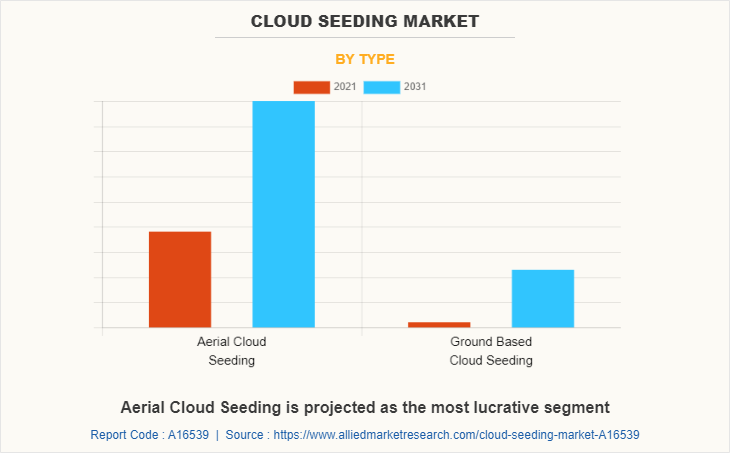
The cloud seeding market is segmented on the basis of type, application, flare type, seeding technique, and region. By type, it is categorized aerial cloud seeding and ground based cloud seeding. Depending on application, it is fragmented into increasing precipitation, mitigating hail damage, and dispersing fog. By flare type, it is divided into end burning flares, ejection flares, automatic/remote based generator, manual generator, and flare trees. By seeding technique, the market is divided into hygroscopic, and glaciogeneic. Region-wise, the market is analyzed across North America, Europe, Asia-Pacific, and LAMEA.
Companies have adopted product development and product launch as their key development strategies in the cloud seeding industry. Moreover, collaborations and acquisitions are expected to enable leading players to enhance their product portfolios and expand into different regions. The key players operating in the cloud seeding market are Weather Modification, Inc., RHS Consulting, Limited, North American Weather Consultants, Inc., Seeding Operations And Atmospheric Research, Snowy Hydro Limited, Mettech S.p.A., AFJets Sdn Bhd, Cloud Seeding Technologies, 3D s.a., and Ice Crystal Engineering LLC.
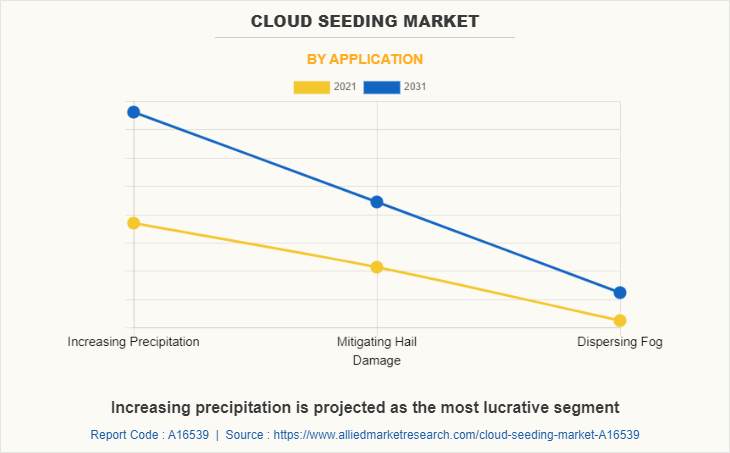
Usage of cloud seeding technologies to regulate weather patterns
The rise in global warming and carbon footprint at alarming levels across the globe, backed by range of industrial and logistics activities is having a notable impact on weather pattern. Major season such as summer, winter, and monsoon across the globe is getting irregular. Extreme weather conditions, heat and cold waves, and large storms are expected to become a common occurrence in coming years. Almost quarter of the world, including major economies such as the U.S., Russia, China, UK, India, and UAE recorded highest temperature in their respective geographies in 2021. Such catastrophic situations have allowed environmental researchers to come with a viable solution to control weather.
Cloud seeding technique can increase precipitation in cloud and augment rainfall or snowfall as and when needed. Commercial application like use of aerial or ground-based cloud seeding to have a consistent environmental conditions around runways are being practiced for several years. Extreme weather conditions like fog, hail or ice can limit the aircraft ability to land and takeoff, generating a demand of regular cloud seeding operations.
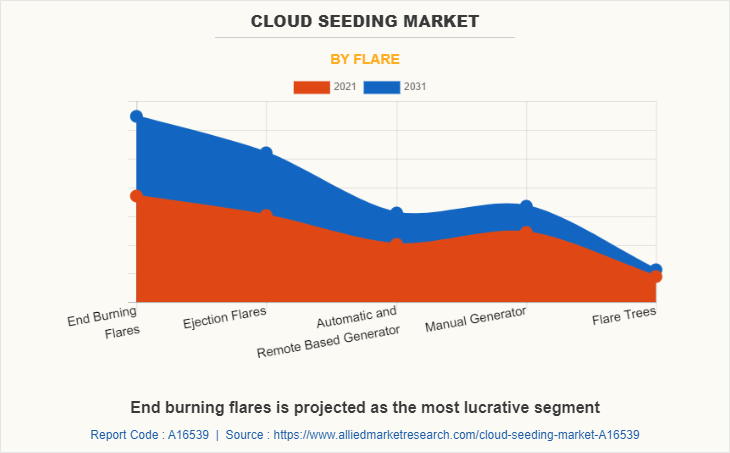
Reduce the catastrophic impact of natural disasters
The environmental shift due to increase in pollution and uneven weather conditions is generating catastrophic impact on societies across the globe. Flash floods, thunderstorms, uneven rainfall, heat strokes, and hail storms are becoming a common phenomenon, incurring notable losses to human society. An average of $20 billion of losses every year is incurred by the U.S. due to hail damage. An average of more than 1,000 hail events are recorded every year across the U.S. and the number keeps on increasing every year. In May 2020, a hail storm in South Texas area caused notable damage, summing the amount to $1.4 billion. Apart from the U.S., other countries such as Germany, China, and Australia are also suffering from similar consequences. Cold regions including Canada and Russia suffer from extreme snowfall, challenging the day to day operations, whereas the dessert regions such as UAE, are suffering from extreme water scarcity due to lack of rain.
Cloud seeding technologies can help notably reduce this catastrophic impacts. Chemicals like silver iodide and sodium chloride used in cloud seeding can accelerate the precipitation of catastrophic clouds and reduce the total damage that is expected to incur. For instance, a cloud having extreme snow or rain particles approaching civilian region can be cloud seeded in jungle area. The cloud seeding will ensure the cloud precipitation and disasters can be mitigated.
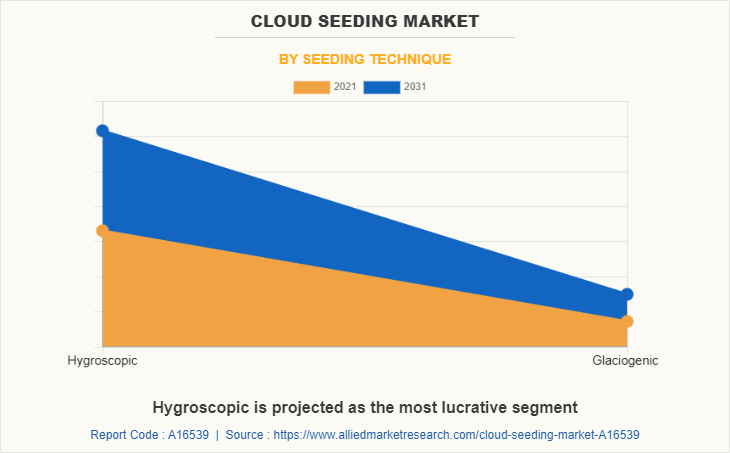
Continued growth in population to generate water demand
The rise in population across the globe and increasing demand of fresh water to various day to day personal and professional activities to support adoption of cloud seeding technologies. These weather modification technique will allow regions to cater the rising market demand of fresh water through increase cloud precipitation activities. The population is expected to grow over 40% in next 45% with growth rate of 1.1% per year. Countries in Asia-Pacific and North America will have the highest population density where countries in Africa and Asia-Pacific has the highest growth rate. The increasing population density and growth rate will become a primary factor driving the consumption of clean water and indirectly creating a demand for cloud seeding market.
Challenges in commercial acceptance
Weather modification through cloud seeding is a complex process which may have a long term impact over the atmosphere, if it is used in a continuous manner. Despite cloud seeding has been used for decades, there is no conclusive results about its success ratio which is creating a hurdle in widespread commercial acceptance. Another major factor hindering the commercial acceptance is the fact that cloud seeding cannot be done on every cloud. There needs to be specific weather conditions such as minimum density of cloud which can be seeded to have optimal results. Advanced weather forecast and monitoring technologies are required to rectify such clouds, limiting its business opportunities.
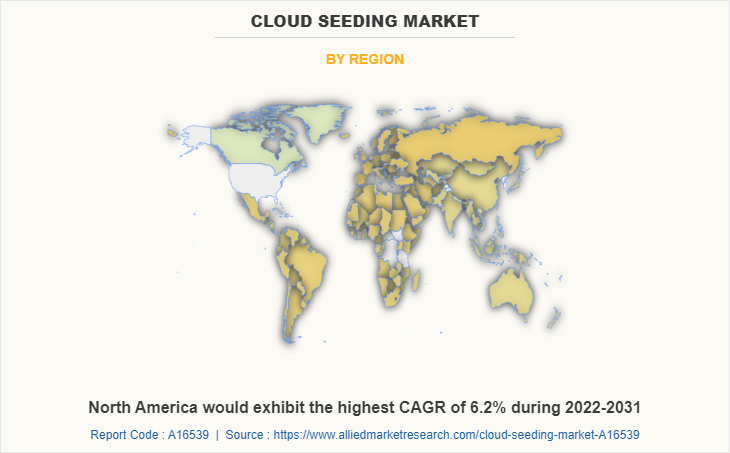
KEY BENEFITS FOR STAKEHOLDERS
- This study presents the analytical depiction of the global cloud seeding market analysis along with the current trends and future estimations to depict imminent investment pockets.
- The overall cloud seeding market opportunity is determined by understanding profitable trends to gain a stronger foothold.
- The report presents information related to the key drivers, restraints, and opportunities of the global cloud seeding market with a detailed impact analysis.
- The current cloud seeding market is quantitatively analyzed from 2021 to 2031 to benchmark the financial competency.
- Porter’s five forces analysis illustrates the potency of the buyers and suppliers in the industry.
Cloud Seeding Market Report Highlights
| Aspects | Details |
| By Type |
|
| By Application |
|
| By Flare |
|
| By Seeding Technique |
|
| By Region |
|
| Key Market Players | SEEDING OPERATIONS AND ATMOSPHERIC RESEARCH, WEATHER MODIFICATION, INC, NORTH AMERICAN WEATHER CONSULTANTS, INC, Ice Crystal Engineering, 3D s.a, AFJets Sdn Bhd, RHS CONSULTING, LIMITED, Mettech S.p.A, snowy hydro limited, CLOUD SEEDING TECHNOLOGIES |
Analyst Review
The cloud seeding market is expected to undergo a major shift in the coming years. Adoption of weather modification through cloud seeding technologies, backed by government funding to support business potential within the cloud seeding market during the forecast period. The cloud seeding was first experiment in 1946 by Vincent Schaefer, a chemist in General Electric. However, the commercial applications of cloud seeding technologies was initiated in late 20th century. Gradual development in technology and challenges in terms of commercial acceptance are among the primary factors that have hindered the growth of cloud seeding market.
The rise in awareness about cloud seeding technologies and increase in commercial acceptance supported by government initiatives play a major role in defining business dynamics of market during the forecast period. Government of UAE, the U.S., China, and India are already taking aggressive steps towards commercial integration of cloud seeding technologies and cater to the existing demand for water scarcity. The North America and Europe nations are inclined towards using cloud seeding technologies for disaster management through mitigation of hail storms and dispersion fog.
The cloud seeding technologies are expected to increase rainfall by 10-15%, but there are lot of challenges that are being faced by industry players. Not all clouds are capable of generating rain, even after seeding. Hence, to ensure right clouds are seeded, it requires extreme weather monitoring technologies. Also, many scientist and environment activists are opposing the concept of cloud seeding, further catering challenge to the cloud seeding market growth. The primary chemical being used in cloud seeding technologies is silver iodide, which is toxic to aquatic life. Though current level of toxicity induced due to cloud seeding is not harmful to the environment, scientist predict that excessive usage of these chemicals may have a negative impact.
Among the analyzed regions, North America is the highest revenue contributor, followed by Asia-Pacific, LAMEA, and Europe. Asia-Pacific is expected to witness the highest growth rate during the forecast period, owing to increasing efforts of the Indian and Chinese governments to develop cloud seeding infrastructure. Initiatives taken by these governments to promote indigenous manufacturing and operational capabilities will also contribute to the growth of the region.
Increase in cloud seeding application by the arrival of the private service provider to propel growth opportunities .
Optimizing weather cycles, increasing cloud precipitation, and generating artificial rain and snowfall are among the primary application of cloud seeding technologies.
North America is the largest regional market for cloud seeding.
The global cloud seeding market was valued at $120.4 million in 2021, and is projected to reach $192.8 million by 2031, registering a CAGR of 5.1% from 2022 to 2031.
The key players operating in the cloud seeding market are Weather Modification, Inc., RHS Consulting, Limited, North American Weather Consultants, Inc., Seeding Operations And Atmospheric Research, Snowy Hydro Limited, Mettech S.p.A., AFJets Sdn Bhd, Cloud Seeding Technologies, 3D s.a., and Ice Crystal Engineering LLC.
Loading Table Of Content...


